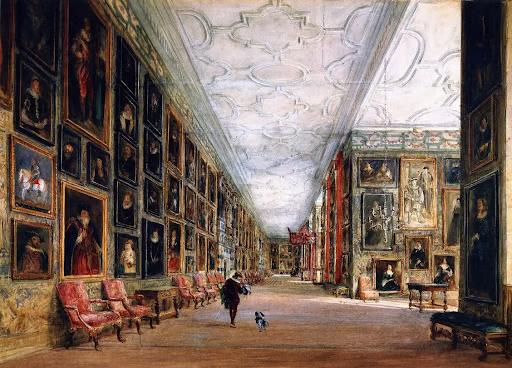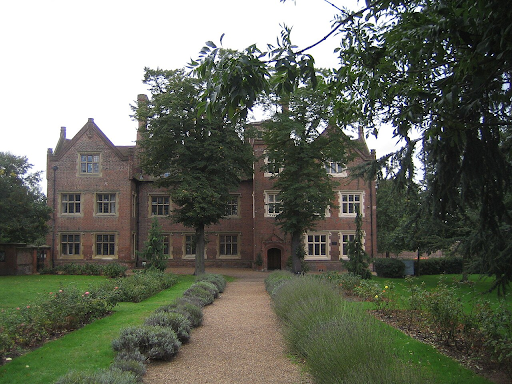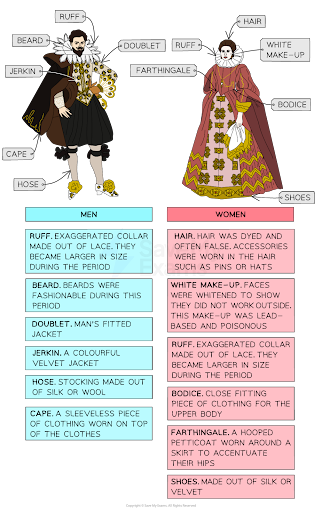Lifestyles, Homes & Fashion in Elizabethan Times (WJEC Eduqas GCSE History): Revision Note
Exam code: C100
What was England like in Elizabethan England? - Summary
Life in Elizabethan England varied significantly across social classes. For the poorer classes, daily existence was challenging. Their daily life contained hard agricultural labour and poor living conditions. Their diets were poor, mainly consisting of bread, pottage, and the occasional piece of meat.
The nobility enjoyed a life of relative luxury and privilege. Their large estates and wealth allowed for better lifestyles. This included large feasts, expensive clothing, and a variety of entertainment. They had significant political influence and often engaged in court life.
The gentry, a class below the nobility, also experienced a comfortable life, though less extravagant. They owned smaller estates and were often involved in local government and trade. Education was valued among the gentry, and many sought to maintain their social status through strategic marriages and purchasing land.
Contrasting Lifestyles of the Rich & Poor
Elizabethan society was a clearly divided society
It had a very structured class system that kept everyone in their social class
At the top of the system was the monarch, Elizabeth
Underneath the monarch are the nobles and lords
They were landowners with an income of up to £6,000 per year
Followed by the gentry
Who were lesser landowners with an income of up to £200 a year
Under the gentry were the wealthy merchants and professionals
This was a new class that was made up of lawyers and businessmen
Next were yeomen and tenant farmers
Some yeomen owned their own land and had some servants
Tenant farmers rented from a landowner
Near the bottom of Elizabethan society were cottagers and skilled artisans
Cottagers had a small garden or farm
Skilled artisans were men with trades
Such as blacksmiths
At the bottom were landless skilled labourers, the poor, and the unemployed
Image
Life of the Rich in Elizabethan Society
Sons of wealthy nobles and lords were tutored at home and were taught
The classics
French
Latin
Greek
Social etiquette
Hunting
Hawking
Dancing
Whereas daughters were tutored by a governess and were taught
Domestic skills
Music
Dancing
Social etiquette
The wife of a nobleman or lord was expected to run the household, including
The staff
Food
House upkeep
Children’s education
Social events
Life of the Gentry in Elizabethan Society
The gentry lived a similar lifestyle to those who were richer than they were, such as the nobility, but not on the same scale
Education
Sons of the gentry attended grammar school
There were approximately 360 grammar schools during this period
Some of the most famous grammar schools from this period include Rugby and Harrow
They were taught subjects aimed at instruction on how to be a gentleman, including
Greek
Latin
Social etiquette
Hunting
Fencing
Music
Dancing
Sports
Including tennis and bowls
The school day was long, starting at 6 am and finishing at 7 pm
Life of the Poor in Elizabethan Society
The lower classes' lifestyle was very different from that of the richer classes
Education
Most poor people were not educated during the Elizabethan period
Those who were educated went to local parish schools
They were taught basic reading and writing
Most left school before they were teenagers to work
They spent most of their time working
When they were not working, they would
Visit a local tavern or inn
Gamble in cock or bare-bailing
Play dice or cards
Fish
Watch a play
Work
Most of the poorer classes were tenant farmers and labourers
They would work long hours
From 5 am - 5 pm
Elizabethan Homes & Fashions
Elizabethan Homes for the Rich
The Elizabethan period was known as the ‘Great Rebuilding’
Wealthy Elizabethans built many stately homes or renovated their homes
This was possible due to
Land was brought during the dissolution of the monasteries in Henry VIII's reign
Agricultural changes
Mineral resources
Inheritance and marriage
Trade
Before the Elizabethan era, the main function of a home for the higher classes was for security and protection
Homes were built with
Defensive features like walls and gates
A communal great hall where people ate, worked, and slept
Narrow windows with shutters and no glass
During the Elizabethan period, homes were created for:
Comfort
Fashion
As a display of people’s wealth and intellect
Homes were inspired by the French and Italian Renaissance. This is evident in the following features:
The geometric plasterwork
Features such as the loggia
Symmetrical layout of the houses
Often in the shape of an ‘E’ or ‘H’
Oak wooden panelling
Stonework
New materials were being used, including
Bricks
For the construction of chimneys or used as an infill between beams
Glass
For windows
Gardens, as well as houses, were remodelled during the Elizabethan period
Before this period, the garden was used to grow food for the house
Gardens were now used for
Entertainment
Pleasure
Exercise
Displaying wealth
Gardens followed the same design and inspiration as the rest of the Elizabethan houses
Gardens were
Symmetrical
Inspired by Renaissance styles
There are many examples of Elizabethan houses in this style, including:
Hardwick Hall, Derbyshire
Created by Bess of Hardwick between 1590 and 1597

Burghley House, Lincolnshire
Built by William Cecil and completed in 1587

There were several new features in these Elizabethan homes
The long gallery ran the whole length of a house, usually on the upper floor
Long galleries were created as a place to walk when the weather was poor
They were spaces to play games, listen to music, and dance
Long galleries were opened or closed so they could be used in the winter or the summer months
In a long gallery, you would find
Family portraits
Portraits of the royal family
Small tables
Chests
Stools
Games

Family wings would contain
A parlour containing
A sitting room
Tapestries
Wooden panelling
Plastered ceilings
A large fireplace
Bedrooms with
Fourposter beds for privacy and warmth
A selection of furniture, including dressers and chairs
A master bedroom
With a ‘withdrawing room’ next door for servants to sleep in
Servant quarters included
Kitchen
Bedrooms
They would sometimes have been in the old great hall
Elizabethan Homes for the Gentry
Many members of the gentry and yeomen tried to copy the same fashions and home improvements as the richer people in Elizabethan society, but on a much smaller scale
Homes were modernised by
Building houses with brick
Introducing servant quarters
Decorating with tapestries, stone work, wooden paneling, and large open fireplaces
Using glass in their windows
Built chimneys

Examiner Tips and Tricks
In this exam, question 4 will ask you to explain the connections between three out of four features. For example, it may ask you to ‘Explain the connections between two of the following that are to do with the lifestyle of the rich:
Education
Fashion
New building designs
The long gallery ‘
To achieve the higher bands, you must explain the connections between all three features, not just a single link.
Elizabethan Homes for the Poor
The poorer classes lived in smaller homes
These homes would have
One room
An earth floor
Walls made of a timber frame and wattle and mud infill
A thatched roof
A few pieces of furniture, including a bed, table, and stools
Animals would often share the living space
Elizabethan Fashion for the Rich and Gentry Classes
Fashion was very important during the Elizabethan period because it was:
A way of showing your wealth
A status symbol
In 1562, Elizabeth passed laws to control what people wore
These laws were a way to reinforce hierarchy in Elizabethan England
Fashion differed between men and women; however, some fashion items were a must for both
Elizabethan Fashion for the Poor Classes
The poorer classes lived in such poverty that they owned very simple clothes
It was likely that they only had one or two spare items of clothing
Men mainly owned
One pair of leather shoes
Knitted woolen stockings
Leather breeches
A doublet
A jerkin
A felt hat
Women mainly owned
A petticoat
Mantle
Doublet
Kerchief
A net or cap
One pair of leather shoes

Elizabethan Fashion for the Poor Classes
The poorer classes lived in such poverty that they owned very simple clothes
It was likely that they only had one or two spare items of clothing
Men mainly owned
One pair of leather shoes
Knitted woolen stockings
Leather breeches
A doublet
A jerkin
A felt hat
Women mainly owned
A petticoat
Mantle
Doublet
Kerchief
A net or cap
One pair of leather shoes
Worked Example
What can be learnt from Sources A and B about houses during the Elizabethan times?
Source A
“The ancient manors and houses of our gentlemen are strong timber … such as be built lately are either of brick or stone, or both; their rooms large and comfortable. Those of the nobility are … so magnificent and stately.”
[An Account from the book Description of England by William Harrison in 1577. Harrison commented on the changes in buildings and the lifestyle of Elizabethans.]
Source B

[4 marks]
Answer:
The sources show that the houses in Elizabethan England were becoming larger, more comfortable, and fashionable. Source A shows that many houses were now made from brick or stone, instead of timber (1). This shows that not only were homes stronger, but their owners had more money to be able to afford these more expensive materials (1). Source B shows that the interior of homes was richly decorated with expensive furnishings such as a four-poster bed and tapestries (1). This also shows that homes were no longer for defensive purposes but for comfort and a place to show off their wealth (1).
Examiner Tips and Tricks
When answering question 1, only sources A and B should be used in your answer. Many students include their own knowledge; however, this question does not reward marks for their own knowledge.

Unlock more, it's free!
Did this page help you?